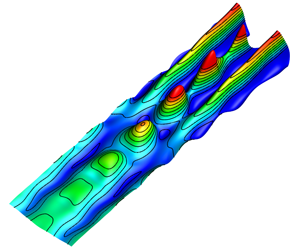Article contents
Structure evolution at early stage of boundary-layer transition: simulation and experiment
Published online by Cambridge University Press: 11 March 2020
Abstract

The beginning of laminar–turbulent transition is usually associated with a wave-like disturbance, but its evolution and role in precipitating the development of other flow structures are not well understood from a structure-based view. Nonlinear parabolized stability equations (NPSE) were solved numerically to simulate the transition of K-regime, N-regime and O-regime. However, only the K-regime transition was examined experimentally using both hydrogen bubble visualization and time-resolved tomographic particle image velocimetry (tomo-PIV). Based on the ‘NPSE visualization’ and ‘tomographic visualization’, at least four common characteristics of the generic transition process were identified: (i) inflectional regions representing high-shear layers (HSL) that develop in vertical velocity profiles, accompanied by ejection–sweep behaviours; (ii) low-speed streak (LSS) patterns, manifested in horizontal timelines, that seem to consist of several three-dimensional (3-D) waves; (iii) a warped wave front (WWF) pattern, displaying multiple folding processes, which develops adjacent to the LSS in the near-wall region, prior to the appearance of 𝛬-vortices; (iv) a coherent 3-D wave front, similar to a soliton, in the upper boundary layer, accompanied by regions of depression along the flanks of the wave. It was determined that the amplification and lift-up of a 3-D wave causes the development of the HSL, WWF and multiple folding behaviour of material surfaces, that all contribute to the development of a 𝛬-vortex. The amplified 3-D wave is hypothesized as a soliton-like coherent structure. Based on our results, a path to transition is proposed, which hypothesizes the function of the WWF in boundary-layer transition.
JFM classification
- Type
- JFM Papers
- Information
- Copyright
- © The Author(s), 2020. Published by Cambridge University Press
References
Jiang et al. supplementary movie 1
Evolution of timelines initiated at 𝑦 = 1.71 for K-regime transition. The upper row is the side view of timelines, the middle row is the plane view of timelines, and the lower row is the plane view of the timeline surface, with contour lines and color indicating the wall-normal distance (𝑦). The sections of A-A and B-B show the end views of the cross section curves at 𝑥 = 1180 and 1240.
Jiang et al. supplementary movie 2
Evolution of timelines initiated at 𝑦 = 3.83 for K-regime transition. The upper row is the side view of timelines, the middle row is the plane view of timelines, and the lower row is the plane view of the timeline surface, with contour lines and color indicating the wall-normal distance (𝑦).
Jiang et al. supplementary movie 3
Evolution of timelines initiated at 𝑦 = 1.71 for O-regime transition. The upper row is the side view of timelines, the middle row is the plane view of timelines, and the lower row is the plane view of the timeline surface, with contour lines and color indicating the wall-normal distance (𝑦). The sections of A-A and B-B show the end views of the cross section curves at 𝑥 = 1000 and 1080.
Jiang et al. supplementary movie 4
Jiang et al. supplementary movie 5
Evolution of timelines initiated at 𝑦 = 1.71 for N-regime transition. The upper row is the side view of timelines, the middle row is the plane view of timelines, and the lpwer row is the plane view of the timeline surface, with contour lines and color indicating the wall-normal distance (𝑦). The sections of A-A and B-B show the end views of the cross section curves at 𝑥 = 1175 and 1280.
Jiang et al. supplementary movie 6
Evolution of timelines initiated at 𝑦 = 3.83 for N-regime transition. The upper row is the side view of timelines, the middle row is the plane view of timelines, and the lower row is the plane view of the timeline surface, with contour lines and color indicating the wall-normal distance (𝑦).
- 26
- Cited by




